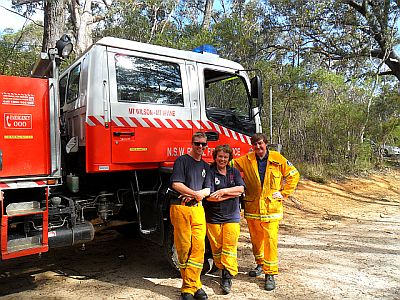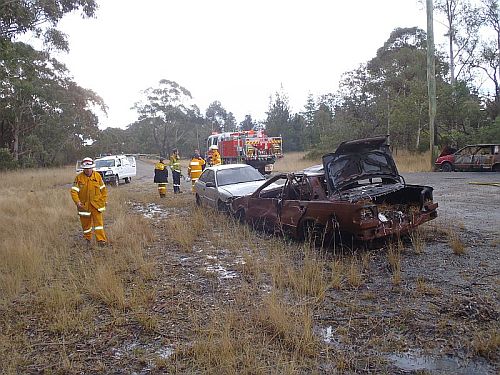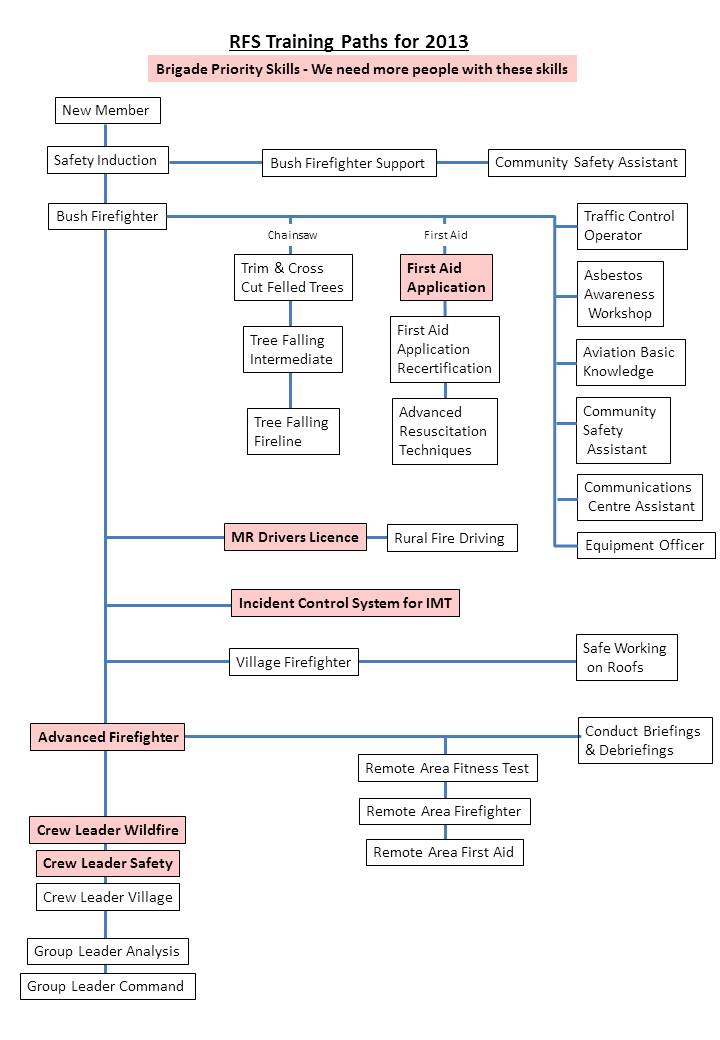- Details
New South Wales Rural Fire Service fire fighters are required to undergo formal fire training that is aligned to Australian Qualification Framework (AQF) National Competencies before being able to attend fires and incidents. This training is presently provided at training centres located within the Blue Mountains Rural Fire District, District Office at Katoomba or at the Mt Wilson Fire Station. Continual training, skills maintenance and updating of skill sets is provided at brigade level and is essential to maintaining a member's fire fighting competencies.
The Mt Wilson / Mt Irvine Brigade takes training very seriously. We feel the more knowledge and skills we have the safer it will be for us, and we will be able to serve the community at a higher standard. The minimum requirement for fire fighting is Bush Fire fighter (BF).
We pride ourselves in the knowledge that when our members attend courses, they already are prepared and have a good knowledge of what the particular course entails. We strive for the members to exceed in the basic knowledge and skills of the course.
As mainstream NSWRFS courses are nationally accredited; if you move or are involved in operations in another state other than NSW, your accreditations will be automatically recognised.
We have courses in chainsaw operation, community engagement (community safety), catering and communications. Below is a flowchart outlining just some of the operational training you can do. There are many more specialist and support courses available as you progress through the RFS.
Some members who join the Brigade wish to become involved by supporting the folk who are out on trucks and to help with the running of the Brigade. A series of courses are available for this type of role and to start along this path one should complete the Bush Firefighter Support course.
Bush Firefighter Support
Bush Fire Support (BFS) is a program for non-fire fighting members who may operate in the vicinity of bush fires or undertake roles that support active firefighting. It is a shorter version of BF that includes BF safety and theory knowledge but not the associated physical fire fighting skills. It is specially tailored for people like station officers who man a station, or communications officers, catering and other support staff who might need to operate on the fireground, but aren’t firefighters as such.
Below is a brief outline of the core training courses for operational front line fire fighters:
Bushfire Fighter
When you become a volunteer with the N.S.W. Rural Fire Service you will be asked to undertake training in Bush Fire fighting.
Bushfire fighters must have the competence required to allow them to fight bush and grass fires in rural, bush and urban environments. These members will have the skills and knowledge to enable them to:
- work safely on the fire ground
- have an appreciation of fire behaviour
- use various techniques to suppress a fire
- use and care for fire fighting equipment
- use and care for communications equipment
- work in a team
Bushfire fighters will always be under appropriate supervision. Members cannot attend any fire incident until they have completed the required training.
Village Fire Fighter

VF Certification completed Nov 2010
Fire behaviour in buildings and vehicles often depends on quite different factors from those that influence bush fires, and they may present different hazards to fire fighters. Village fires usually also develop much faster. This means that the ability to quickly receive a call, respond fire fighting units and commence fire fighting at the scene is much more critical than in grass or bush fire fighting.
Village Fire fighter courses are delivered and assessed by qualified trainers and assessors. The course involves instructor-led theory and practical sessions, in addition to self-paced post-course activities covering:
- structural fire behaviour
- gas fire behaviour
- motor vehicle fires and accidents
- urban interface fire fighting
- use of equipment in a structural fire environment
- fire ground procedures
Advanced Fire Fighter
The level above Basic Fire fighter is the Advanced Fire fighter (AF). This level provides you with the competency to fight bush and grass fires without constant and direct supervision. The course involves instructor-led theory and practical sessions, in addition to self-paced post-course activities, covering:
- maintenance of fire fighting equipment
- map reading and navigation
- hydraulics and pumping
- human factors in fire fighting
- incident safety
- fire weather and behaviour
- fire prevention and community safety activities
Some of these subjects are introduced during Bush Firefighter (BF) and Village Firefighter (VF) training however Advanced Firefighter (AF) training covers these topics in greater depth.
Crew Leader
 What do Crew Leaders do? After you have the pre-requisite qualifications to become a Crew Leader, you may be wondering what Crew Leaders do. Here are some things that Crew Leaders typically do at an incident:
What do Crew Leaders do? After you have the pre-requisite qualifications to become a Crew Leader, you may be wondering what Crew Leaders do. Here are some things that Crew Leaders typically do at an incident:
- ensure the crew is ready to respond
- brief the crew on the way to an incident
- size up the incident upon arrival
- assume CONTROL and/or command your crew
- decide the most appropriate fire fighting tactics to use on the fire ground, sometimes under stressful conditions
- communicate the overall strategy and tactics to the crew
- task the crew and other units
- adjust tactics and tasks if needed
- call for more resources if needed
- handle crises and unexpected situations that arise on the fire ground
Here are some things that Crew Leaders who are Brigade Officers typically do when they are not at an incident:
- participate in hazard reduction activities
- help identify individual training needs of the crew
- help the crew prepare for incidents
- conduct area and equipment familiarisation activities.
- conduct site inspections
- build teamwork skills so that if something unexpected happens at an incident the crew knows what to do
- supervise maintenance activities
- help with brigade social activities
- coach, mentor and support the crew, both professionally and personally
Here are some things that Crew Leaders get involved in that you may not have known about:
- sort out disputes between members before they escalate to formal complaints
- help deal with personal issues that members come to them with
- represent the Rural Fire Service through community education activities (e.g. talk to scout groups or similar)
- administration (e.g. fill in incident report forms)
- rostering and sorting out crew shortages

